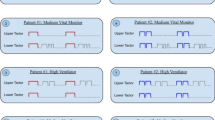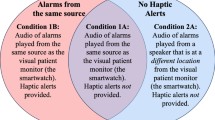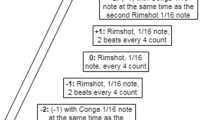Abstract
The design of medical alarms has been heavily criticized in the past decade. Auditory medical alarms have poor learnability, discernibility, and relevance, leading to poor patient outcomes, and alarm fatigue, and overall poor informatic system design. We developed a novel trimodal patient monitoring smartwatch application for patient monitoring. Participants completed two phases: (1) control and (2) our novel trimodal system while identifying alarms (heart rate, oxygenation, and blood pressure) and completing a cognitively demanding task. Alarms were auditory icons presented as either solo or co-alarms. Participant performance was assessed by accuracy and response time (RT) of alarm identification. Using the novel system, accuracy was significantly improved overall (p < 0.01) and in co-alarm situations (p < 0.01), but not for solo alarms (p = 0.484). RT was also significantly faster (p < 0.01) while using the novel system for all alarm types. Participants reported decreased mental workload using the novel system. This feasibility study shows that our novel alarm system performs better than current standards. Improvements in accuracy, RT and perceived mental workload indicate the potential of this system to have a positive impact on medical informatic systems and clinical monitoring, for both the patient and the clinician.

Similar content being viewed by others
Data Availability
By request to the corresponding author.
Code Availability (software application or custom code)
By request to the corresponding author.
References
Top 10 Health Technology Hazards 2020 (2020). https://assets.ecri.org/PDF/White-Papers-and-Reports/ECRI-Top-10-Technology-Hazards-2020-v2.pdf.
Edworthy JR et al (2018) Getting Better Hospital Alarm Sounds into a Global Standard. Ergonomics in Design 26: 4–13. https://doi.org/10.1177/1064804618763268
Sendelbach S, Funk M (2013) Alarm Fatigue: A Patient Safety Concern. AACN Advanced Critical Care 24:378–386. https://doi.org/10.4037/NCI.0b013e3182a903f9
Claudio D, Deb S, Diegel E. (2021). A Framework to Assess Alarm Fatigue Indicators in Critical Care Staff. Critical Care Explorations, 3(6). https://doi.org/10.1097/CCE.0000000000000464
Edworthy J et al (2014) Learning three sets of alarms for the same medical functions: A perspective on the difficulty of learning alarms specified in an international standard. Applied Ergonomics 45: 1291–1296. https://doi.org/10.1016/j.apergo.2013.10.003
Cvach M (2012) Monitor alarm fatigue: an integrative review. Biomedical instrumentation & technology, 46(4):268–277. https://doi.org/10.2345/0899-8205-46.4.268
Gillard J, Schutz M (2012) Improving the efficacy of auditory alarms in medical devices by exploring the effect of amplitude envelope on learning and retention. Georgia Institute of Technology.
Bruder AL, Rothwell CD, Fuhr LI, Shotwell MS, Edworthy JR, Schlesinger JJ (2022) The influence of audible alarm loudness and type on clinical multitasking. Journal of medical systems, 46(1):1–19.
Edworthy JR, McNeer RR, Bennett CL., Dudaryk R, McDougall SJ, Schlesinger J J, & Osborn D (2018). Getting better hospital alarm sounds into a global standard. Ergonomics in Design, 26(4), 4–13. https://doi.org/10.1177/1064804618763268
International Electrotechnical Commission. (2020). IEC 60601-1-8: 2006 + AMD1: 2012 + AMD2: 2020 CSV Consolidated Version. International Electrotechnical Commission: Geneva, Switzerland.
Bolton ML, Zheng X, Li M, Edworthy JR, Boyd AD. An Experimental Validation of Masking in IEC 60601-1-8:2006-Compliant Alarm Sounds. Hum Factors. 2020 Sep;62(6):954–972. doi: 10.1177/0018720819862911. Epub 2019 Aug 14. PMID: 31411902.
Sowan AK, Tarriela AF, Gomez TM, Reed CC Rapp KM (2015) Nurses’ Perceptions and Practices Toward Clinical Alarms in a Transplant Cardiac Intensive Care Unit: Exploring Key Issues Leading to Alarm Fatigue. JMIR Human Factors 2:4196. https://doi.org/10.2196/humanfactors.4196
Schlesinger JJ, Stevenson RA, Shotwell MS, Wallace MT (2014) Improving Pulse Oximetry Pitch Perception with Multisensory Perceptual Training. Anesthesia & Analgesia 118: 1249–1253.https://doi.org/10.1213/ANE.0000000000000222
Burdick KJ et al. (2020) SAVIOR ICU: sonification and vibrotactile interface for the operating room and intensive care unit. J Clin Monit Comput 34:787–796
Burdick KJ et al. (2019) Using Multisensory Haptic Integration to Improve Monitoring in the Intensive Care Unit. Auditory Perception & Cognition 2:188–206. https://doi.org/10.1080/25742442.2020.1773194
Alirezaee P, Weill-Duflos A, Schlesinger JJ Cooperstock JR (2020) Exploring the Effectiveness of Haptic Alarm Displays for Critical Care Environments. 2020 IEEE Haptics Symposium (HAPTICS) 948–954. https://doi.org/10.1109/HAPTICS45997.2020.ras.HAP20.156.6c3cc0bf.
Schlesinger JJ et al (2018) Acoustic features of auditory medical alarms—An experimental study of alarm volume. The Journal of the Acoustical Society of America 143:3688–3697. https://doi.org/10.1121/1.5043396
Cvach M (2014) Managing hospital alarms. Nursing 2020 Critical Care 9:13.
Waltzer S (2020) Global Smartwatch Shipments Grow 20% to 14 million in Q1 2020. Strategy Analytics.
Apple Inc (2022). Human Interface Guidelines Haptics. Haptics - interaction - watchos - human interface guidelines - apple developer. https://developer.apple.com/design/human-interface-guidelines/watchos/interaction/haptics/
Kirchner WK (1958). Age differences in short-term retention of rapidly changing information. Journal of experimental psychology, 55(4):352. https://doi.org/10.1037/h0043688
Hart SG, Staveland LE (1988) Development of NASA-TLX (Task Load Index): Results of empirical and theoretical research. Advances in psychology, 52:139–183. https://doi.org/10.1016/S0166-4115(08)62386-9
Endsley MR, Bolstad CA, Jones DG, Riley JM. (2003). Situation awareness oriented design: from user’s cognitive requirements to creating effective supporting technologies. Proceedings of the Human Factors and Ergonomics Society Annual Meeting (47:268–272). Sage CA: Los Angeles, CA: SAGE Publications. https://doi.org/10.1177/154193120304700304
Finley, J. R., Benjamin, A. S., & McCarley, J. S. (2014). Metacognition of multitasking: How well do we predict the costs of divided attention? Journal of experimental psychology: applied, 20(2), 158. https://doi.org/10.1037/xap0000010
Storm J, Chen HC. The relationships among alarm fatigue, compassion fatigue, burnout and compassion satisfaction in critical care and step-down nurses. J Clin Nurs. 2021 Feb;30(3–4):443–453. https://doi.org/10.1111/jocn.15555. Epub 2020 Nov 28. PMID: 33174282.
Katzman N et al. (2019) Evaluation of tactile cues for simulated patients’ status under high and low workload. Proceedings of the Human Factors and Ergonomics Society Annual Meeting63, 658–662. https://doi.org/10.1177/1071181319631285
Edworthy, J. R., Parker, C. J., & Martin, E. V. (2022). Discriminating between simultaneous audible alarms is easier with auditory icons. Applied Ergonomics, 99, 103609.
Acknowledgements
The authors would like to thank Christia Victoriano, Yoanna Ivanova, and Zachary Eidman for their assistance with methodology and data collection.
Funding
All authors have no sources of funding to report.
Author information
Authors and Affiliations
Contributions
KB: This author wrote the manuscript and was involved in all the revisions and writing of the manuscript. She also helped with interpretation of the data and provided assistance with the figures and tables. MG: This author acquired and analyzed all data for the study. This author assisted in writing the manuscript and was involved in revisions. AS: This author was involved in all the revisions and writing of the manuscript and provided assistance with the figures and verification of results and statistical analyses. JS: This author oversaw the entire project. This author also contributed to writing the manuscript and overseeing and contributing to all the revisions and interpretation and application of data.
Corresponding author
Ethics declarations
Conflict of Interest
On behalf of all authors, the corresponding author states that there is no conflict of interest.
Ethics Approval
This study was performed in line with the principles of the Declaration of Helsinki. Approval was granted by the Vanderbilt University Institutional Review Board in 2021.
Consent to Participate
Waiver of Informed Consent was obtained from each participant.
Consent for Publication
Not applicable.
Additional information
Publisher’s Note
Springer Nature remains neutral with regard to jurisdictional claims in published maps and institutional affiliations.
Rights and permissions
Springer Nature or its licensor holds exclusive rights to this article under a publishing agreement with the author(s) or other rightsholder(s); author self-archiving of the accepted manuscript version of this article is solely governed by the terms of such publishing agreement and applicable law.
About this article
Cite this article
Burdick, K.J., Gupta, M., Sangari, A. et al. Improved Patient Monitoring with a Novel Multisensory Smartwatch Application. J Med Syst 46, 83 (2022). https://doi.org/10.1007/s10916-022-01869-1
Received:
Revised:
Accepted:
Published:
DOI: https://doi.org/10.1007/s10916-022-01869-1




